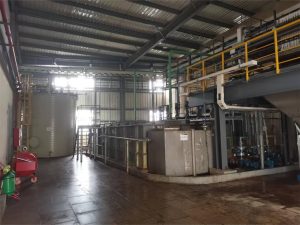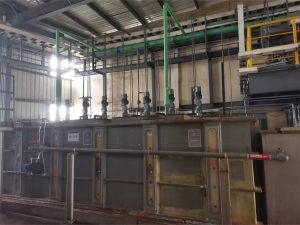Solvent extraction involves selecting an optimal solvent, mixing thoroughly, separating phases effectively, and recovering 95% of the solvent for reuse.
Selection of Solvent
In the solvent extraction process, choosing the right solvent is very important. Developing a solvent needs to dissolve the desired components without significantly altering other components. Through this selectivity, it ultimately provides a high yield and high purity of the extracted substance.
Solvent Properties
The perfect solvent will be specific, it will break down a specific chemical in a certain way without dissolving other substances found. For example, when decaffeinating coffee beans, people often use methylene chloride because it is very selective for caffeine
Solvent Polarity
Another consideration is the polarity of the sequence. Solvents can be either non-polar or polar. Polar solvents like water or ethanol are used to extract polar-polar compounds, while non-polar solvents like hexane or benzene are used to extract non-polar compounds. It depends on the extractability in question.
Solvent Compatibility and Safety
Both are very important in terms of the compounds being extracted and safety considerations. Boiling point is a key property; the lower the boiling point of the solvent, the easier it evaporates. In addition, the solvent must be non-toxic and must not react with the substances/equipment used in the process.
Cost and Availability
Affordability and availability are also two other must-haves. Some solvents are well suited for extraction but are expensive or difficult to obtain in useful quantities. For example, hexane is preferred over more expensive and difficult to obtain solvents for lipid extraction due to cost.
Environmental Impact
Environmental issues are more important than ever. Solvents must have no or little impact on the environment, be recyclable and meet required regulatory standards. Green chemistry shifts the focus to using less harmful solvents such as ethanol
Mixing and Contacting
Efficient mixing and contacting are vital to maximize the interaction between the solvent and the substance being extracted. Proper techniques ensure the solvent thoroughly penetrates the material, enhancing the extraction efficiency.
Mixing Techniques
Various mixing techniques are employed depending on the scale and nature of the extraction. Mechanical agitation using stirrers or shakers is common in laboratory settings. For larger operations, industrial mixers or agitators are used to ensure uniform contact. For example, in the extraction of essential oils, large-scale mixers help achieve a high yield.
Contact Time
Contact time plays a crucial role in the efficiency of the extraction. Too short a contact time may result in incomplete extraction, while too long can lead to the extraction of unwanted compounds. Optimizing contact time is essential. In a typical scenario, like the extraction of plant alkaloids, an optimal contact time might range from 30 minutes to several hours, depending on the solvent and material.
Temperature Control
Temperature control significantly impacts the extraction process. Higher temperatures generally increase the solubility of the target compound in the solvent, thus enhancing extraction efficiency. For instance, in the extraction of natural pigments, temperatures around 50-60°C are often used to optimize yield without degrading the compound.
Phase Contact Area
The surface area of contact between the phases directly affects the rate of extraction. Increasing the surface area by using smaller particle sizes of the solid material or employing finely dispersed droplets in liquid-liquid extraction enhances efficiency. For example, in the extraction of metals from ores, crushing the ore into finer particles increases the contact area, thus improving extraction rates.
Equipment Considerations
Specialized equipment can enhance mixing and contacting. Rotary extractors, Soxhlet extractors, and continuous extractors are designed to provide optimal mixing and contact. For instance, a Soxhlet extractor allows continuous extraction with minimal solvent use, making it ideal for laboratory-scale operations.
Real-World Application
In industrial applications, such as the extraction of antibiotics from fermentation broths, precise control over mixing and contacting conditions is critical. The use of automated systems to regulate mixing speed, contact time, and temperature ensures consistent product quality and maximized yield.

Separation of Phases
The separation of phases is a critical step in solvent extraction, where the goal is to efficiently and effectively separate the solvent phase from the extracted material. This ensures a pure and concentrated product, ready for further processing or use.
Gravity Separation
Gravity separation leverages the density difference between the solvent and the extract. For instance, in liquid-liquid extractions, the denser phase settles at the bottom while the lighter phase forms a layer on top. Separatory funnels are commonly used in laboratory settings, allowing precise control and efficient phase separation.
Centrifugation
Centrifugation is utilized when gravity separation is insufficient due to minor density differences. High-speed centrifuges apply centrifugal force, accelerating the separation process. For example, in the pharmaceutical industry, centrifugation is employed to separate fine suspensions, ensuring a high-purity product.
Decantation
Decantation involves carefully pouring off the top layer of liquid after the phases have separated. This method is simple yet effective for clear separations. In the extraction of plant oils, decantation helps remove the oil-rich solvent from the aqueous phase, minimizing contamination.
Filtration
Filtration is used when solids need to be removed from liquids. Filter papers, membrane filters, and industrial filtration systems help achieve this. For instance, in the extraction of herbal compounds, filtration removes plant debris, leaving a clean solvent extract.
Automated Separation Systems
In industrial applications, automated separation systems enhance efficiency and consistency. Continuous extractors and automated separators ensure the continuous and precise separation of phases, reducing manual intervention and potential errors. For instance, in the petrochemical industry, automated systems handle large volumes of solvent and extract with high precision.
Real-World Applications
Oil extraction from seeds often uses a combination of methods. After initial solvent extraction, gravity separation and centrifugation remove the bulk of the solvent, while filtration ensures the final product is free from solid impurities. This multi-step approach maximizes yield and purity, ensuring high-quality oil for consumer use.

Solvent Recovery
Solvent recovery is the final step in the solvent extraction process, focusing on reclaiming and recycling the solvent used. This step is essential for both economic and environmental reasons, reducing costs and minimizing waste.
Distillation
Distillation is one of the most common methods for solvent recovery. It involves heating the solvent mixture to separate components based on their boiling points. For example, ethanol can be recovered from a mixture by heating it to 78°C, its boiling point, allowing it to evaporate and then condense back into a pure liquid. This method ensures high purity and is widely used in industries such as pharmaceuticals and chemicals.
Evaporation
Evaporation is another effective technique, especially for solvents with lower boiling points. Rotary evaporators are commonly used in laboratories to gently remove solvents under reduced pressure, enhancing the evaporation rate and preventing thermal degradation of sensitive compounds. For instance, in natural product extraction, rotary evaporation can efficiently remove solvents like hexane or methanol.
Membrane Separation
Membrane separation technologies, such as nanofiltration and reverse osmosis, offer innovative approaches for solvent recovery. These methods use selective membranes to separate the solvent from the extracted compounds. For example, in wastewater treatment, membrane separation can reclaim solvents while removing contaminants.
Adsorption
Adsorption involves passing the solvent mixture through a bed of adsorbent material, which selectively retains the solvent. Activated carbon or zeolites are commonly used adsorbents. In the case of organic solvent recovery from industrial effluents, adsorption can achieve high recovery rates with minimal energy input.
Real-World Applications
In the petrochemical industry, solvent recovery systems are integrated into the production process to reclaim solvents like toluene and xylene. These systems use a combination of distillation and adsorption to achieve high recovery efficiency, reducing operational costs and environmental impact.
Efficiency and Cost-Effectiveness
The efficiency of solvent recovery systems is measured by their recovery rate and the purity of the recovered solvent. For instance, a recovery rate of 95% indicates that only 5% of the solvent is lost, which is economically beneficial. Additionally, the purity of the recovered solvent must meet the required standards for reuse in subsequent extraction processes.
Environmental Considerations
Solvent recovery also plays a crucial role in reducing environmental pollution. By recycling solvents, industries can significantly lower their volatile organic compound (VOC) emissions and minimize hazardous waste. For example, in the paint and coatings industry, solvent recovery systems reduce VOC emissions by up to 80%, contributing to a cleaner environment.
